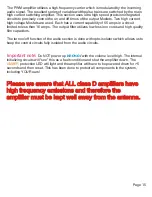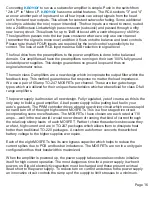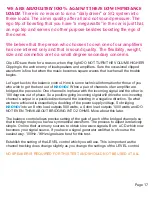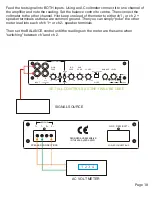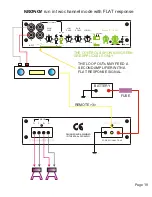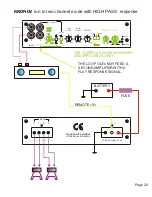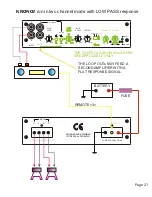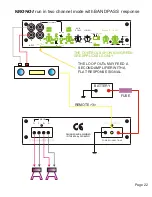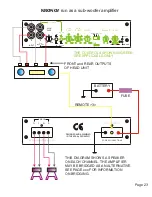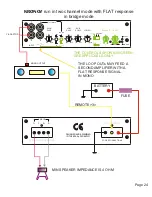
ridging two channels of an amplifier is not a magical thing. Most are mystified by the
B
power figures quoted under the “bridge” column. It is actually very simple. When two
channels are driving a common load, one channel is out of phase with the other by 180
degrees. So when one channel swings positive the other swings negative. There is a
catch however. Each channel “sees” fifty percent of the common load and that means that
each channel of the bridged pair must be capable of delivering current to this lower load
impedance. Thus a 4 ohm bridged load presents a 2 ohm load to each of the bridged
channels. The power into a 4 ohm load in bridged mode is twice the rated 2 ohm power
per channel.
otal Harmonic Distortion - This specification has for years been a benchmark with
T
which to compare one amplifier to another. This is all fine on the test bench where
pure resistive loads are used and sinewaves are amplified. Unfortunately it tells us very
little about the audible performance of an amplifier. Today it is relatively easy to build an
amplifier with THD figures in the “triple oh” region, but what do they sound like. Normally
not very good. To obtain these low THD numbers all we do is design an amplifier with
high open loop gain. That is before negative feedback is applied. Once we apply a lot of
global feedback, we improve all measured parameters such as THD, Noise, Frequency
response, Damping factor. Our amplifiers are designed a little differently. We use very
little global feedback but rather optimize each stage with local feedback. This allows us to
design an amplifier with lower open loop gain and thus we only have to apply about 8dB
of global feedback. Ultra low THD was not our goal but rather an amplifier which sounds
the way we want it to. Other factors affect THD such as PCB layout, grounding and power
distribution to the amplifier channels. Our class A/B amplifier do however achieve very
low distortion due to the fact that we follow the “rules” and their circuit design is
conduscive to low distortion.
ecibel is a unit of measurement. A 100w amplifier has 3dB more power than a 50
D
watt amplifier. This difference is just discernable. A 100 watt amplifier has 1.54dB
more power than a 70watt amplifier. This is not audible. I has been determined that to
hear a difference in “loudness” between to like designed amplifier, one must double the
power. To hear a doubling in loudness one must have TEN TIMES the power (10dB).
eadroom - This term does not refer to how much room there is above your head!
H
Rather it is a specification that signifies how good or bad the power supply is. Zed
Audio has NEVER quoted a headroom specification. Why you may ask? Simple our
amplifiers have no headroom, zero dB, zip dB, nada dB however you say it. A regulated
power supply does not allow the amplifier to have any headroom. A quote from a well
respected designer who said that amplifiers with many dB of headroom simply have
poorly designed power supplies, either through ignorance or to save costs. When one
sees a specification of an amplifier quoting a headroom figure of 3dB this means that the
droop of the power supply is such that when unloaded it is capable of twice the power as
compared to it’s loaded condition.
Page 9

















